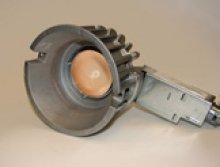Renaissance Lighting, an American small business headquartered in Herndon, Virginia, showcased the SoliaTM lamp, an innovative downlight, at the May 2010 LIGHTFAIR, becoming the first manufacturer to apply a new phosphor-converted LED technology with superior lumen efficacy and color rendering, and offering warm color temperatures. What was the back story behind this promising product introduction? An SBIR-funded research project initiated by Nanomaterials & Nanofabrication Laboratories (NN-Labs, LLC) in 2007.
A cost-effective pathway to creating white LED light, phosphor-converted approaches (pc-LEDs) use a blue-emitting LED die and surround it with a yellow-emitting phosphor powder. The SBIR project addressed the serious challenge of improving the light extraction efficiency—or "package efficiency"—of pc-LEDs. Light extraction had been hampered by poor refractive index matching at the die-encapsulant interface and by back-scattering from the bulk phosphor layer.
NN-Labs researchers solved both problems by incorporating high quantum efficiency doped nanocrystal quantum dots (D-dotsTM) into high-index TiO2 using sol-gel techniques. The resulting scatter-free nanophosphor composites, when embedded into a high-index material, can achieve near index matching with the LED die. Furthermore, D-dots are free of toxic heavy metals, such as the cadmium found in intrinsic nanocrystal emitters.
The D-dots, manufactured in Arkansas, have been incorporated by NNCrystal, a wholly owned subsidiary of Hangzhou Najing Technology, into high quality colloidal nanocrystals called Qshift Lucid. Renaissance Lighting combined Qshift with its patented Constructive Occlusion® optical technology to produce a tunable optic emitter providing 1,600 lumens, an output 30 percent greater than that achieved by comparable phosphor solutions.
Return to Research Highlights


